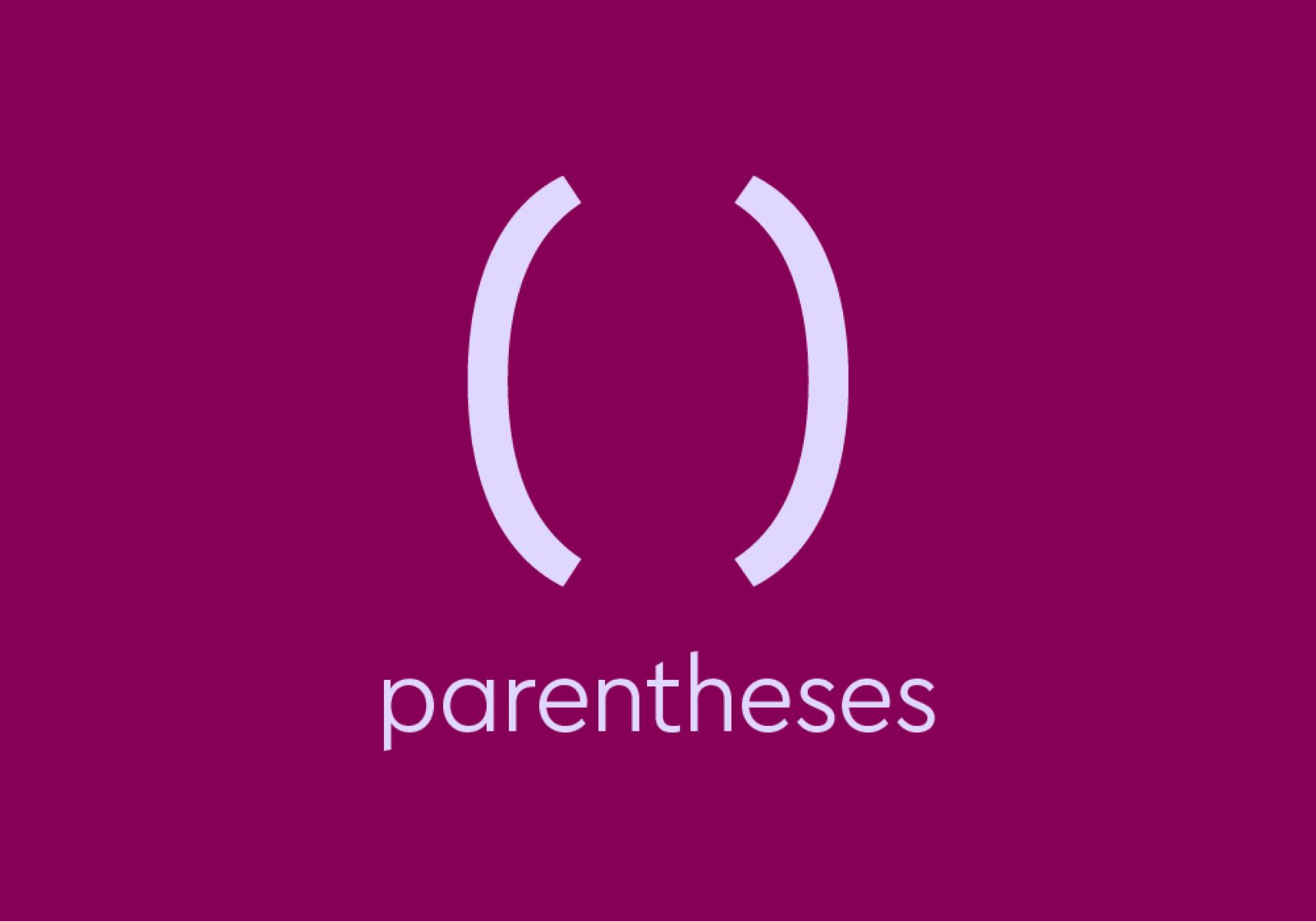

Finance
What Does Parentheses Mean In Accounting
Published: October 10, 2023
Discover the meaning of parentheses in accounting and how they impact financial statements. Explore the importance of understanding finance in managing your business.
(Many of the links in this article redirect to a specific reviewed product. Your purchase of these products through affiliate links helps to generate commission for LiveWell, at no extra cost. Learn more)
Table of Contents
- Introduction
- Overview of Accounting Parentheses
- Purpose of Parentheses in Accounting
- Types of Parentheses in Accounting
- Use of Parentheses in Financial Statements
- Impact of Parentheses on Financial Analysis
- Examples of Parentheses in Accounting
- Common Errors and Misinterpretations Related to Parentheses in Accounting
- Conclusion
Introduction
Welcome to the world of accounting, where numbers speak volumes and financial data tells a compelling story. Within the realm of accounting, there are various conventions and tools that help professionals communicate and interpret financial information accurately and effectively. One such tool is the use of parentheses.
In accounting, parentheses play a crucial role in providing clarity and context to financial statements. They serve as a way to highlight certain figures or transactions that require further explanation or adjustment. Understanding the purpose and proper usage of parentheses in accounting is essential for both finance professionals and those seeking to gain insight into an organization’s financial health.
This article will delve into the world of accounting parentheses, exploring their purpose, types, usage in financial statements, and their impact on financial analysis. We will also examine common errors and misinterpretations related to parentheses in accounting. So, whether you’re a seasoned accountant or just starting to navigate the intricacies of financial statements, buckle up and join us on this informative journey.
Overview of Accounting Parentheses
In accounting, parentheses are used to denote specific information or adjustments within financial statements. They are typically used to enclose figures, notes, or narrative explanations that are deemed significant to the overall understanding of financial data.
Parentheses serve as a visual cue to the reader, drawing attention to specific items that require additional context or clarification. By using parentheses, accountants can provide insights and make adjustments that enhance the accuracy and transparency of financial statements.
It is important to note that the utilization of parentheses in accounting is not standardized across all financial statements. While they are commonly used in some contexts, such as in the footnotes section or when presenting adjusted figures, they may be absent in other parts of the financial statements.
The presence of parentheses in financial statements can vary depending on the reporting framework being used. For example, in generally accepted accounting principles (GAAP), parentheses are often employed to indicate adjustments made to reported figures. On the other hand, in International Financial Reporting Standards (IFRS), such adjustments may be presented using different formatting techniques, and the use of parentheses might be less prevalent.
Overall, the use of parentheses in accounting is driven by the need to provide clear and transparent information to users of financial statements. By encapsulating important elements within parentheses, accountants can effectively communicate and highlight specific items that require attention and understanding.
Purpose of Parentheses in Accounting
The purpose of using parentheses in accounting is multi-fold. Let’s explore the key objectives and functions of parentheses within financial statements:
- Highlight Adjustments: A primary purpose of parentheses in accounting is to draw attention to adjustments made to reported figures. These adjustments may be necessary to correct errors, account for changes in accounting policies, or reflect non-recurring events. By enclosing these figures within parentheses, accountants signal that they have been modified or are not included in the original reported amounts.
- Provide Explanatory Notes: Parentheses are often used to enclose explanatory notes in financial statements. These notes provide additional information about certain figures or transactions, helping readers understand the context or reasons behind specific entries. By using parentheses, accountants can clearly differentiate these notes, making them easily identifiable and accessible to stakeholders.
- Show Non-GAAP Measures: Parentheses are frequently employed to present non-GAAP (Generally Accepted Accounting Principles) measures within financial statements. These measures may include adjusted earnings, non-recurring expenses, or other customized financial metrics that provide a more accurate representation of an organization’s financial performance. The use of parentheses distinguishes these non-GAAP figures from the standard GAAP financial reporting.
- Indicate Negative Figures: Parentheses are commonly used to denote negative figures in accounting. Instead of using a minus sign or negative symbol, parentheses are used to enclose negative values, making them visually distinct. This format ensures that readers can easily identify negative amounts and differentiate them from positive figures.
- Improve Readability and Comprehension: Parentheses enhance the readability and comprehension of financial statements by organizing and segregating specific information. By enclosing related items within parentheses, accountants can help readers quickly identify important details, explanations, or adjustments. This improves the overall understanding of the financial statement and enhances transparency.
Overall, the purpose of parentheses in accounting is to provide clarity, transparency, and context to financial statements. They serve as a means to highlight adjustments, provide additional explanations, and present non-GAAP measures or negative figures effectively. By utilizing parentheses strategically, accountants can enhance the accuracy and comprehensibility of financial information for all stakeholders.
Types of Parentheses in Accounting
In accounting, parentheses can take on different forms to convey specific meanings and provide relevant information. Let’s explore some of the common types of parentheses used in financial statements:
- Adjustment Parentheses: These parentheses are used to indicate adjustments made to reported figures. They are commonly used when presenting adjusted amounts, such as for correcting errors, accounting for changes in accounting policies, or reflecting non-recurring events. Adjustment parentheses highlight that the figures enclosed within them have been modified from the original reported amounts.
- Explanatory Parentheses: Explanatory parentheses are employed to enclose notes or narrative explanations that provide additional context or clarification regarding specific figures or transactions. These notes help readers understand the reasons behind certain entries and provide important details that support the interpretation of financial data.
- Non-GAAP Parentheses: Non-GAAP parentheses are commonly used to present non-GAAP (Generally Accepted Accounting Principles) measures within financial statements. These measures include adjusted earnings, non-recurring expenses, or customized financial metrics that deviate from standard GAAP reporting. Non-GAAP parentheses indicate that the figures enclosed within them are calculated using non-standard accounting methods.
- Negative Parentheses: Negative parentheses are used to denote negative values in accounting. Instead of using a minus sign or negative symbol, negative figures are enclosed within parentheses. This formatting convention ensures that negative amounts are visually distinct and easily identifiable, enabling readers to differentiate them from positive figures.
- Comparison Parentheses: Comparison parentheses are used to present comparative figures in financial statements. They are often used to enclose prior period or benchmark numbers, allowing for easy comparison between different time periods or performance metrics. Comparison parentheses help highlight the changes or variances in financial data, facilitating analysis and trend identification.
These are just a few examples of the types of parentheses used in accounting. The specific usage and formatting of parentheses may vary depending on the reporting standards and practices followed by an organization. However, regardless of the type, parentheses serve the purpose of providing clarity, indicating adjustments, and enhancing the accessibility and comprehension of financial information.
Use of Parentheses in Financial Statements
Parentheses are integral to the presentation of financial statements as they play a crucial role in enhancing transparency and accuracy. Let’s explore the key areas where parentheses are commonly used within financial statements:
- Income Statement: Parentheses are often employed in the income statement to indicate adjustments or non-GAAP measures. For example, if there are significant one-time expenses or gains that are not part of the regular operations, they may be displayed within parentheses to highlight their non-recurring nature. Additionally, negative numbers, such as losses or expenses, are often enclosed in parentheses to distinguish them from positive figures.
- Balance Sheet: In the balance sheet, parentheses are commonly used to indicate adjustments made to reported figures. For instance, if there are significant changes in accounting policies or errors discovered in previous periods, the adjusted amounts may be presented within parentheses. This format helps users of the financial statements understand that the figures enclosed are not part of the original reported amounts.
- Cash Flow Statement: Parentheses in the cash flow statement are primarily used to highlight adjustments or non-GAAP measures. For instance, if there are non-cash transactions or significant non-operating items affecting the cash flow, they may be enclosed within parentheses to draw attention to their distinct nature. Parentheses help users differentiate between cash flow from operating activities and other significant items.
- Footnotes: Parentheses are extensively used in footnotes to provide additional explanations or disclosures related to specific figures or transactions. Footnotes are essential elements of financial statements where important information, such as contingent liabilities, subsequent events, and significant accounting policies, are disclosed. Parentheses help separate and highlight these notes, making them easily accessible for readers.
It is important to note that the use of parentheses may vary depending on the reporting framework and specific requirements of an organization. Some reporting standards, such as GAAP, may prescribe the use of parentheses for specific purposes, while others, such as IFRS, may employ different formatting techniques to achieve similar objectives. Regardless, the primary aim of using parentheses in financial statements is to provide clarity, highlight adjustments, and facilitate the interpretation of financial data.
Impact of Parentheses on Financial Analysis
The use of parentheses in financial statements can have a significant impact on the interpretation and analysis of financial data. Here are some key implications to consider:
- Adjustment Recognition: Parentheses draw attention to adjustments made to reported figures, highlighting items that may significantly impact the overall financial performance of an organization. By enclosing adjusted amounts within parentheses, financial analysts and stakeholders can understand the adjustments and consider their effect on metrics such as revenue, expenses, and profitability.
- Non-GAAP Evaluation: Parentheses are often used to present non-GAAP measures in financial statements. These measures offer alternative perspectives on an organization’s financial performance, as they exclude specific items or adjust for unique circumstances. Financial analysts need to pay attention to these non-GAAP figures within parentheses to gain a comprehensive understanding of an organization’s financial health.
- Comparative Analysis: In financial statements, parentheses are frequently employed to present comparative figures from previous periods. These figures help financial analysts assess the performance of an organization over time and identify trends. By recognizing the figures within parentheses, analysts can easily differentiate and compare data points, enabling them to draw meaningful insights and make informed decisions.
- Transparency and Disclosure: Parentheses, especially in footnotes, provide additional context and disclosures related to specific figures or transactions. These notes can contain critical information, such as contingent liabilities or significant accounting policies, that impact an organization’s financial position. Financial analysts must thoroughly review the information enclosed within parentheses to ensure a comprehensive analysis and accurate understanding of the organization’s financial statements.
It is essential for financial analysts to consider the impact of parentheses in financial analysis. By recognizing and analyzing the figures, adjustments, non-GAAP measures, and comparative data presented within parentheses, analysts can gain a deeper understanding of an organization’s financial performance, identify key drivers, and make informed decisions. Properly interpreting and evaluating the information within parentheses is crucial for conducting thorough and accurate financial analysis.
Examples of Parentheses in Accounting
Let’s explore some examples of how parentheses are used in accounting to provide clarity and highlight important information within financial statements:
- Adjusted Figures: Suppose a company reports revenues of $1,000,000 in its income statement. However, due to an error in the calculation, the actual revenue is $950,000. In this case, the adjusted figure would be presented as ($950,000) within parentheses to indicate the correction made to the reported amount.
- Non-GAAP Measures: A company wants to present its adjusted earnings, excluding one-time expenses. The adjusted earnings figure of $500,000 may be presented as $500,000 in parentheses to highlight that it is a non-GAAP measure and differs from the standard reported earnings figure.
- Disclosure of Contingent Liabilities: In the footnotes section of financial statements, a company discloses a contingent liability related to a pending lawsuit. The estimated liability amount of $1,000,000 is enclosed within parentheses to emphasize that it represents an estimate and is subject to potential changes pending the outcome of the lawsuit.
- Comparative Figures: A company presents its revenue figures for the current year and the previous year in the income statement. The revenue figure for the current year is presented as $2,000,000, while the revenue figure for the previous year is presented as ($1,500,000) within parentheses. The parentheses indicate that the previous year’s revenue figure is presented in a negative form for comparative purposes.
- Errors and Adjustments: Suppose there was an overstatement of expenses in the financial statements. The incorrectly reported expense figure of $100,000 is corrected to $80,000, with the adjusted figure presented as ($80,000) within parentheses to highlight the adjustment made to rectify the error.
These examples demonstrate how parentheses are used in diverse scenarios within financial statements. They showcase the importance of parentheses in clarifying adjustments, presenting non-GAAP measures, disclosing contingent liabilities, indicating comparative figures, and highlighting errors or corrections.
By understanding the proper usage and interpretation of parentheses in accounting and financial statements, analysts can effectively analyze the financial health and performance of organizations, and stakeholders can make informed decisions based on accurate and transparent financial information.
Common Errors and Misinterpretations Related to Parentheses in Accounting
While parentheses serve an important purpose in accounting and financial statements, there are certain common errors and misinterpretations that can arise. It is essential to be aware of these potential pitfalls to ensure accurate analysis and understanding of the financial information presented. Here are some examples:
- Failure to Recognize Adjustments: One common error is overlooking the figures presented within parentheses and treating them as part of the original reported amounts. Financial analysts must pay close attention to parentheses to identify adjustments made to reported figures and consider their impact on the overall financial analysis.
- Misinterpretation of Non-GAAP Measures: Non-GAAP figures presented within parentheses can be misinterpreted if not properly understood. These measures are often adjusted or calculated using different accounting methods. It is crucial to thoroughly understand the explanations and rationale provided for the non-GAAP figures to avoid misinterpretation and incorrect analysis.
- Ignoring Footnotes: Footnotes play a significant role in providing important contextual information within financial statements. However, stakeholders sometimes overlook footnotes, including the information presented within parentheses. This can lead to missed disclosures, misunderstandings, and incomplete analysis. It is crucial to carefully review footnotes, including information enclosed in parentheses, to gain a comprehensive understanding of the financial statements.
- Misreading Negative Figures: Negative figures enclosed within parentheses can be misread if not given proper attention. It is essential to recognize that the use of parentheses to denote negative values is a formatting convention in accounting. Misinterpreting negative figures can significantly impact the analysis and understanding of financial data.
- Incorrect Comparison Interpretation: When comparing figures from different time periods or making year-over-year comparisons, misinterpretation of comparative figures presented within parentheses can occur. The figures enclosed in parentheses represent the prior period or benchmark numbers, and understanding their purpose and significance is essential for accurate analysis.
To avoid these errors and misinterpretations, it is important to approach financial statements with a critical eye, paying attention to details, and understanding the specific usage of parentheses in different sections of the statements. Careful reading, thorough analysis, and a clear understanding of accounting principles are crucial in accurately interpreting financial information presented within parentheses.
Conclusion
Parentheses play a vital role in the realm of accounting, providing clarity, context, and transparency to financial statements. Their usage within financial statements helps accountants communicate adjustments, present non-GAAP measures, disclose important information, and highlight comparative figures. By understanding the purpose and proper interpretation of parentheses, financial analysts and stakeholders can accurately analyze and interpret financial data.
Throughout this article, we have explored the overview, purpose, types, usage, and impact of parentheses in accounting. We have seen how parentheses are used to denote adjustments, enclose explanatory notes, present non-GAAP measures, highlight negative figures, and indicate comparative data. We have also identified common errors and misinterpretations related to parentheses and the importance of considering these factors when analyzing financial statements.
Recognizing the significance of parentheses and their implications in financial analysis is crucial for making informed decisions and gaining a comprehensive understanding of an organization’s financial health. By paying attention to the figures presented within parentheses, thoroughly reviewing footnotes, and understanding the specific usage of parentheses in different parts of financial statements, stakeholders can navigate through financial data with accuracy and confidence.
In conclusion, parentheses in accounting serve as valuable tools that enhance the transparency, accuracy, and comprehension of financial statements. With a clear understanding of their purpose and proper interpretation, stakeholders can confidently analyze financial data, identify key insights, and make well-informed decisions for the benefit of organizations and their stakeholders.














